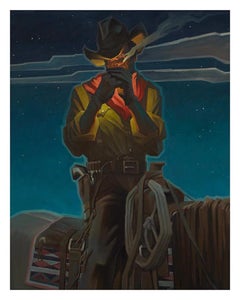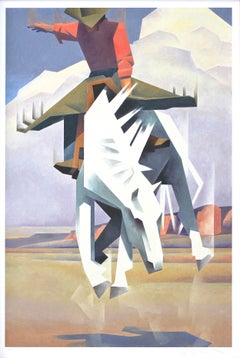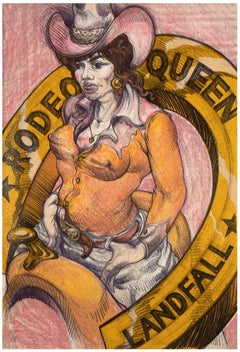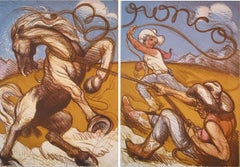Want more images or videos?
Request additional images or videos from the seller
1 of 5
Ed MellEd Mell, This Palomino Ain't No Pal of Mine, Giant Size, 54 x 36 in , Special Ed
Price:$13,500
About the Item
- Creator:Ed Mell (1942, American)
- Dimensions:Height: 54 in (137.16 cm)Width: 34 in (86.36 cm)
- Medium:
- Movement & Style:
- Period:
- Condition:
- Gallery Location:Phoenix, AZ
- Reference Number:1stDibs: LU2623215167112
About the Seller
No Reviews Yet
Vetted Professional Seller
Every seller passes strict standards for authenticity and reliability
1stDibs seller since 2023
8 sales on 1stDibs
Authenticity Guarantee
In the unlikely event there’s an issue with an item’s authenticity, contact us within 1 year for a full refund. DetailsMoney-Back Guarantee
If your item is not as described, is damaged in transit, or does not arrive, contact us within 7 days for a full refund. Details24-Hour Cancellation
You have a 24-hour grace period in which to reconsider your purchase, with no questions asked.Vetted Professional Sellers
Our world-class sellers must adhere to strict standards for service and quality, maintaining the integrity of our listings.Price-Match Guarantee
If you find that a seller listed the same item for a lower price elsewhere, we’ll match it.Trusted Global Delivery
Our best-in-class carrier network provides specialized shipping options worldwide, including custom delivery.You May Also Like
"Here, From Over There" 2021
By Justin Pollmann
Located in New York, NY
Justin Pollmann "Here, From Over There" 2021
Inkjet Transfer Collage, Monotype
18.5"x14" inches
The inkjet transfer images are made by collaging transfers of inkjet prints to the ...
Category
2010s Contemporary Abstract Prints
Materials
Paper, Inkjet
"Memory Exercise" 2020
By Justin Pollmann
Located in New York, NY
Justin Pollmann "Memory Exercise" 2020
Inkjet Transfer Collage, Monotype
19.5"x17.5" inches
The inkjet transfer images are made by collaging transfers of inkjet prints to the pape...
Category
2010s Contemporary Abstract Prints
Materials
Paper, Inkjet
"Diary of a Summer Day" 2021
By Justin Pollmann
Located in New York, NY
Justin Pollmann "Diary of a Summer Day" 2021
Inkjet Transfer Collage, Monotype
33"x22" inches
The inkjet transfer images are made by collaging transfers of inkjet prints to the pa...
Category
2010s Contemporary Abstract Prints
Materials
Paper, Inkjet
"Parallel Journey" 2023
By Justin Pollmann
Located in New York, NY
Justin Pollmann "Parallel Journey" 2023
Inkjet Transfer Collage, Monotype
37"x24" Inches
The inkjet transfer images are made by collaging transfers of inkjet prints to the paper’...
Category
2010s Contemporary Figurative Prints
Materials
Paper, Inkjet
"For Best Results, Cut Along The Belief Bias" 2023
By Justin Pollmann
Located in New York, NY
Justin Pollmann "For Best Results, Cut Along The Belief Bias" 2023
Inkjet Transfer Collage, Monotype
17"x15" Inches
The inkjet transfer images are made by collaging transfers of i...
Category
2010s Contemporary Figurative Prints
Materials
Paper, Inkjet
"In Every Dreamhouse A" 2022
By Justin Pollmann
Located in New York, NY
Justin Pollmann "In Every Dreamhouse A" 2022
Inkjet Transfer Collage, Monotype
36"x34" Inches
The inkjet transfer images are made by collaging transfers of inkjet prints to the pa...
Category
2010s Contemporary Figurative Prints
Materials
Paper, Inkjet
"Hang It Up" 2022
By Justin Pollmann
Located in New York, NY
Justin Pollmann "Hang It Up" 2022
Inkjet Transfer Collage, Monotype
28"x22" inches
The inkjet transfer images are made by collaging transfers of inkjet prints to the paper’s surfa...
Category
2010s Contemporary Abstract Prints
Materials
Paper, Inkjet
"Day by Daybed" 2023
By Justin Pollmann
Located in New York, NY
Justin Pollmann "Day by Daybed" 2023
Inkjet Transfer Collage, Monotype
25"x27.5" inches
The inkjet transfer images are made by collaging transfers of inkjet prints to the paper’s ...
Category
2010s Contemporary Abstract Prints
Materials
Paper, Inkjet
"Save Me a Seat" 2023
By Justin Pollmann
Located in New York, NY
Justin Pollmann "Merging Egality" 2023
Inkjet Transfer Collage, Monotype
18"x13" nches
The inkjet transfer images are made by collaging transfers of inkjet prints to the paper’s s...
Category
2010s Contemporary Abstract Prints
Materials
Paper, Inkjet
"Unstuck" 2022
By Justin Pollmann
Located in New York, NY
Justin Pollmann "Unstuck" 2022
Inkjet Transfer Collage, Monotype
24"x17" Inches
The inkjet transfer images are made by collaging transfers of inkjet prints to the paper’s surface ...
Category
2010s Contemporary Figurative Prints
Materials
Paper, Inkjet
More From This Seller
View AllLet the Devil Take Tomorrow by Greg Singley
Located in Phoenix, AZ
SHIPPING FEES INCLUDE SHIPPING CHARGE, PACKAGING & **INSURANCE**
Let the Devil Take Tomorrow
Greg Singley
Signed: Lower right
Archival Pigment Print
Image size: 28 x 22 inches
Pape...
Category
2010s Contemporary Figurative Prints
Materials
Digital, Digital Pigment
Ed Mell, This Palomino Ain't No Pal of Mine, Giant Size, 54 x 36 in , Special Ed
By Ed Mell
Located in Phoenix, AZ
This Palomino Ain’t No Pal of Mine 1982
Giant Size, Special Limited Edition
Archival Pigment Print
Original Pencil Signature, Signed Lower Right
Made in collaboration with Ed Mell
...
Category
1980s Contemporary Figurative Prints
Materials
Digital
Rodeo Queen by Luis Jimenez
Located in Phoenix, AZ
Rodeo Queen, 1981
Edition 36/50
Signed lower left, Inscribed: for the "Rose" 82.
Provenance: Print was a gift to Rozanne Charington, companion and model for "Rodeo Queen", "Rose Tattoo" and "Jimenez at Adeliza's Candy Store".
Lithograph on paper
42 ½ × 29 in. (107.3 × 73.7 cm)
Luis Alfonso Jimenez
Born, 1940, El Paso, Texas, died 2006, Hondo, New Mexico.
Statement: Luis Jimenez, in his work, celebrates the vitality of life. . . . Jimenez es un hijo de la frontera; he knows its people and the landscape. It is the transformation of these people into art that is his most important contribution to the art of this vast region which stretches between Mexico and the United States.
His subject matter utilizes the popular images of the cultura del norte, and a large part of it is depicted and transformed in the rough and tumble world of la frontera. He is also a son of el norte, and so he uses its materials and explores its emerging, popular myths. The tension and attraction of Jimnez’s work is that he always creates within the space of his two worlds, the Mexicano and the Americano. He constantly shows us the irony of the two forces which repel, while showing us glimpses of the synthesis he seeks. What a gift it has been to us for this talented artist to reflect on the soul of our region. He gives meaning to our existence and history.
Rudolfo Anaya (passage chosen by the artist), A View from La Frontera, Man on Fire: Luis Jimenez, pp. 1, 3, 6Biography: Luis Jimenez was born in Texas to parents who had emigrated from Mexico to the United States; he would later dedicate his 1989 sculpture Border Crossing to his father, who had entered the country illegally. The elder Jimenez was a neon sign designer in El Paso, and Luis worked with him as a youth. His experience working in the neon shop and his fascination with U.S. car culture would both become major influences on his art career.
Jimenez studied architecture at the University of Texas, Austin (UTA), and also took art courses in which he first created sculptures with wood, steel, and fiberglass, choosing the latter because of its association with U.S. popular culture. He subsequently became one of the artists who made fiberglass an acceptable medium in the 1960s. In 1964 Jimenez received his B.S. in art from UTA, and he continued his studies at the Universidad Nacional Autonoma de Mexico in Mexico City.
In 1966 he moved to New York City and worked as an assistant to sculptor Seymour Lipton. Jimenez began to exhibit his art while in New York and in 1972 moved to New Mexico to focus on creating public sculptures, even as he maintained his diverse output of drawings, prints, and lithographs.
Drawing on his early experiences, Jimenez creates works that come from a border perspective, one that draws upon the hybridity bred by culture clashes. Often socially and politically informed, his works speak not only in regional terms, those germane to the southwestern United States, but to broader, more global issues as well. They exhibit a profoundly Chicano aesthetic and sensibility, one that is informed by Mexican and Mexican American traditions, North American popular culture, Chicano cultural icons, and images and themes unique to the Southwest. Death, sexuality, and the struggle of the common people are frequent themes.
Inspired by authors who write in an autobiographical style, Jimenez creates works that function as personal narrative yet are also able to make statements about culture in more global terms. His use of bold colors and lines, a legacy from his fathers work as a neon sign maker, lends a dynamic sensuality to his work, one that is particularly evident in his monumental fiberglass and acrylic urethane sculptural works
Many of Jimenez's works correspond to scholar Toms Ybarra-Fraustos definition of the Chicano aesthetic of rasquachismo, a lowbrow sensibility that appeals to the working class in that it applies to objects that subvert expressions of the mainstream or dominant culture. Creating art that speaks to the people, Jimenez is able to transform regional and culturally specific myths and symbols into globally recognized and relevant icons.
Exhibitions:
In addition to his personal work, Jimenez has been commissioned for numerous public art projects. In 1999 his sculpture Southwest Piet was designated a National Treasure by First Lady Hillary Clinton.
The many exhibitions featuring his work have included Human Concern/Personal Torment (Whitney Museum of American Art, New York, 1969).
The First International Motorcycle Art Show (Phoenix Art Museum, Phoenix, AZ, 1973).
Three Texas Artists (Centre Cultural Americaine, USIS, Paris, 1977),
Recent Trends in Collecting (Smithsonian Institution, Washington, DC, 1982).
Committed to Print (Museum of Modern Art, New York, 1989)
Printmaking in Texas: The 1980s (Modern Art Museum, Fort Worth, TX.
Laguna Gloria Art Museum, Austin, 1990.
The Whitney Biennial (Whitney Museum of American Art, New York, 1991)
Man On Fire: Luis Jimnez (Albuquerque Museum of Art, NM, 1994-95).
47th Annual Purchase Exhibition (American Academy of Arts and Letters, New York, 1995).
Traveling solo exhibition, Working Class Heroes: Images from the Popular Culture (1997-2000).
Jiménez
Collier Gallery has been in continuous operation for over 40 years. Originally located just off Main Street in downtown Scottsdale, Arizona, we have moved to Phoenix to accommodate and showcase our large inventory including:
• Original works by Maynard Dixon, Lon Megargee, Ed Mell, Fritz Scholder, Bill Schenck, Bill Lesch, Luis Jimenez, Greg
Singley, Dan Budnik, and other 20th century Western, WPA and Contemporary Southwestern artists.
• The Fine Art Estate of Lon Megargee
• Vintage rodeo...
Category
1980s Contemporary Figurative Prints
Materials
Lithograph
Bronco
Located in Phoenix, AZ
SHIPPING FEES INCLUDE SHIPPING CHARGE, PACKAGING & **INSURANCE**
Luis Alfonso Jimenez
Born, 1940, El Paso, Texas, died 2006, Hondo, New Mexico.
Statement: Luis Jimenez, in his work, celebrates the vitality of life. . . . Jimenez es un hijo de la frontera; he knows its people and the landscape. It is the transformation of these people into art that is his most important contribution to the art of this vast region which stretches between Mexico and the United States.
His subject matter utilizes the popular images of the cultura del norte, and a large part of it is depicted and transformed in the rough and tumble world of la frontera. He is also a son of el norte, and so he uses its materials and explores its emerging, popular myths. The tension and attraction of Jimnez’s work is that he always creates within the space of his two worlds, the Mexicano and the Americano. He constantly shows us the irony of the two forces which repel, while showing us glimpses of the synthesis he seeks. What a gift it has been to us for this talented artist to reflect on the soul of our region. He gives meaning to our existence and history.
Rudolfo Anaya (passage chosen by the artist), A View from La Frontera, Man on Fire: Luis Jimnez, pp. 1, 3, 6Biography: Luis Jimnez was born in Texas to parents who had emigrated from Mexico to the United States; he would later dedicate his 1989 sculpture Border Crossing to his father, who had entered the country illegally. The elder Jimnez was a neon sign designer in El Paso, and Luis worked with him as a youth. His experience working in the neon shop and his fascination with U.S. car culture would both become major influences on his art career.
Jimenez studied architecture at the University of Texas, Austin (UTA), and also took art courses in which he first created sculptures with wood, steel, and fiberglass, choosing the latter because of its association with U.S. popular culture. He subsequently became one of the artists who made fiberglass an acceptable medium in the 1960s. In 1964 Jimenez received his B.S. in art from UTA, and he continued his studies at the Universidad Nacional Autnoma de Mexico in Mexico City.
In 1966 he moved to New York City and worked as an assistant to sculptor Seymour Lipton. Jimnez began to exhibit his art while in New York and in 1972 moved to New Mexico to focus on creating public sculptures, even as he maintained his diverse output of drawings, prints, and lithographs.
Drawing on his early experiences, Jimnez creates works that come from a border perspective, one that draws upon the hybridity bred by culture clashes. Often socially and politically informed, his works speak not only in regional terms, those germane to the southwestern United States, but to broader, more global issues as well. They exhibit a profoundly Chicano aesthetic and sensibility, one that is informed by Mexican and Mexican American traditions, North American popular culture, Chicano cultural icons, and images and themes unique to the Southwest. Death, sexuality, and the struggle of the common people are frequent themes.
Inspired by authors who write in an autobiographical style, Jimnez creates works that function as personal narrative yet are also able to make statements about culture in more global terms. His use of bold colors and lines, a legacy from his fathers work as a neon sign maker, lends a dynamic sensuality to his work, one that is particularly evident in his monumental fiberglass and acrylic urethane sculptural works
Many of Jimnezs works correspond to scholar Toms Ybarra-Fraustos definition of the Chicano aesthetic of rasquachismo, a lowbrow sensibility that appeals to the working class in that it applies to objects that subvert expressions of the mainstream or dominant culture. Creating art that speaks to the people, Jimnez is able to transform regional and culturally specific myths and symbols into globally recognized and relevant icons.
Exhibitions:
In addition to his personal work, Jimnez has been commissioned for numerous public art projects. In 1999 his sculpture Southwest Piet was designated a National Treasure by First Lady Hillary Clinton.
The many exhibitions featuring his work have included Human Concern/Personal Torment (Whitney Museum of American Art, New York, 1969).
The First International Motorcycle Art Show (Phoenix Art Museum, Phoenix, AZ, 1973).
Three Texas Artists (Centre Cultural Americaine, USIS, Paris, 1977),
Recent Trends in Collecting (Smithsonian Institution, Washington, DC, 1982).
Committed to Print (Museum of Modern Art, New York, 1989)
Printmaking in Texas: The 1980s (Modern Art Museum, Fort Worth, TX.
Laguna Gloria Art Museum, Austin, 1990.
The Whitney Biennial (Whitney Museum of American Art, New York, 1991)
Man On Fire: Luis Jimnez (Albuquerque Museum of Art, NM, 1994-95).
47th Annual Purchase Exhibition (American Academy of Arts and Letters, New York, 1995).
Traveling solo exhibition, Working Class Heroes: Images from the Popular Culture (1997-2000).
Jiménez
Collier Gallery has been in continuous operation for over 40 years. Originally located just off Main Street in downtown Scottsdale, Arizona, we have moved to Phoenix to accommodate and showcase our large inventory including:
• Original works by Maynard Dixon, Lon Megargee, Ed Mell, Fritz Scholder, Bill Schenck, Bill Lesch, Luis Jimenez, Greg
Singley, Dan Budnik, and other 20th century Western, WPA and Contemporary Southwestern artists.
• The Fine Art Estate of Lon Megargee
• Vintage rodeo...
Category
1970s Contemporary Figurative Prints
Materials
Lithograph
Apache Mountain Spirit Dancer
Located in Phoenix, AZ
SHIPPING CHARGES INCLUDE SHIPPING, PACKAGING & **INSURANCE**
Apache Mountain Spirit Dancer
James Rome
Etching 62/100
Image: 21.75 x 27.5 inches
Paper: 25 x...
Category
1980s Contemporary Figurative Prints
Materials
Etching
Down to the Valley by Bill Schenck
By Bill Schenck
Located in Phoenix, AZ
Down in the Valley
Bill Schenck
Serigraph 46/50
Edition of 50
Image size: 25 x 29 inches
Paper size: 31 x 35 inches
SHIPPING CHARGES INCLUDE SHIPPING, PACKAGING & INSURANCE
UNFRAM...
Category
1990s Contemporary Figurative Prints
Materials
Screen
Still Thinking About These?
All Recently ViewedMore Ways To Browse
Kaws Untitled
Keith Haring Best Buddies
Keith Haring David Bowie
Keith Haring Future Primeval
Kin Choi Lam
Kunisada Triptych
La Petite Corrida
Leon Boullet
Leroy Neiman Posters
Lithograph By Mirror
Lithograph Picasso 1957
Make Art Not War
Marc Chagall Poster Framed
Marc Chagall The Lovers
Marino Marini Shakespeare
Mary Cassatt Etchings
Matisse Signed Print
Max Baer



